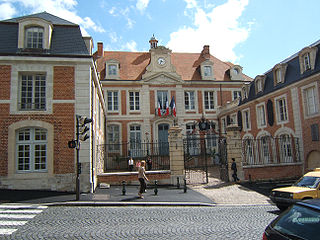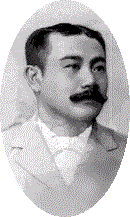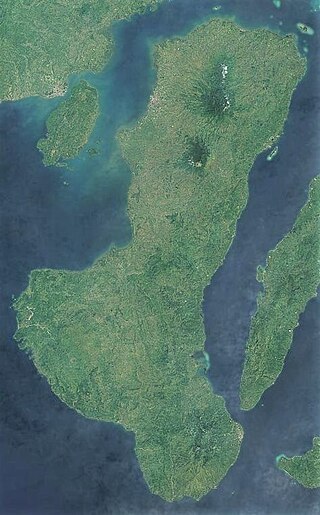This article needs additional citations for verification .(December 2011) |
Yves Leopold Germain Gaston was the patriarch of a large family with roots in the City of Silay, in the province of Negros Occidental, Philippines.
This article needs additional citations for verification .(December 2011) |
Yves Leopold Germain Gaston was the patriarch of a large family with roots in the City of Silay, in the province of Negros Occidental, Philippines.
The real and legal surname of Yves Leopold was in fact Germain. He was born in Lisieux, France, the twenty third of the month of Brumaire, Year twelve of the French Republic at six o’clock evening. [1] (November 15 1803 in Gregorian calendar). Son of Pierre Germain, National Gendarme professional, and Marie Anne Logre married. Later on, he adopted the very French-sounding name of Gaston, certainly because for a Frenchman, the surname Germain created too many problems and confusion. The Name Gaston was retained by the following generations as their surname.
He settled in the Philippines, where he is credited as the first to commercially produce cane sugar, [2] the primary product of the province.
Gaston first moved to Calatagan, Batangas in 1837 to help Domingo Róxas, a prominent businessman and ancestor of the Zóbel de Ayala family, set up his sugar business. It was there that Gaston met Prudencia Fernandez, who later became his wife. When his partner's business did not prosper, the Frenchman decided to try his prospects first in Iloilo and from there, he ventured to Negros. He arrived at the port city of Silay in 1840, [3] where he found the soil conducive to planting sugarcane. He brought in an iron mill or "horno economico", which at that time was virtually unheard of.

The iron mill allowed him to begin commercial production of export-quality sugar. The Spaniards endorsed his residence in the Philippines due to the impact of his technology on the economy. He had become a sugar baron and was exporting the product alongside Nicholas Loney, the first British vice-consul in the country who, because of his efforts to promote sugar, became known as the "Father of the Sugar Industry." Gaston later decided to bring his family to back to France. However, on the way, he fell ill and eventually died. His wife and three children, not knowing a word of French, returned to Silay and permanently settled there, continuing the family business. The sugar industry soon peaked, and sugarcane became the staple crop throughout Negros Occidental.
The house of Gaston's eldest son is now a museum open to the public and is fondly called the Balay Negrense (Hiligaynon, "The Negrense House").

José Gaston, grandson of Yves Leopold Germain Gaston, built another house called the Hacienda Rosalia in Manapla, Negros Occidental, also open to the public.

Negros Occidental, officially the Province of Negros Occidental, is a province in the Philippines located in the Negros Island Region. Its capital is the city of Bacolod, of which it is geographically situated and grouped under by the Philippine Statistics Authority, but remains politically independent from the provincial government and also one of the two regional centers in Negros Island Region. It occupies the northwestern half of the large island of Negros, and borders Negros Oriental, which comprises the southeastern half. Known as the "Sugarbowl of the Philippines", Negros Occidental produces more than half the nation's sugar output.

Bacolod, officially the City of Bacolod, is a 1st class highly urbanized city in the Negros Island Region in the Philippines. With a total of 600,783 inhabitants as of the 2020 census, it is the most populous city in the Negros Island Region and the second most populous city in the entire Visayas after Cebu City.

Lisieux is a commune in the Calvados department in the Normandy region in northwestern France. It is the capital of the Pays d'Auge area, which is characterised by valleys and hedged farmland.

La Carlota, officially the City of La Carlota,, is a 4th class component city in the province of Negros Occidental, Philippines. According to the 2020 census, it has a population of 66,664 people. making it the least populous city in the province.

Silay, officially the City of Silay, is a 3rd class component city in the province of Negros Occidental, Philippines. According to the 2020 census, it has a population of 130,478 people.

Talisay, officially the City of Talisay, is a fourth class component city in the province of Negros Occidental, Philippines. According to the 2020 census, it has a population of 108,909 people.

Aniceto Ledesma Lacson is a Filipino revolutionary general, sugar farmer, and businessman. He is known as the first and only president of the Negros Republic from 1898 to 1901, and for leading the Negros Revolution alongside Juan Araneta.

The Negros Revolution, commemorated and popularly known as the Fifth of November or Negros Day, was a political movement that in 1898 created a government on Negros Island in the Philippines, ending Spanish control of the island and paving the way for a republican government run by the Negrense natives. The newly established Negros Republic lasted for approximately three months. American forces landed on the island unopposed on February 2, 1899, ending the island's independence. Negros was then annexed to the Philippine Islands on 20 April 1901.
Alfredo Montelíbano Sr. was a Filipino politician and industrialist. He served as the first mayor of Bacolod in 1938, as military governor of Negros and Siquijor Islands from 1942 to 1945, and as Secretary of National Defense and Interior under President Sergio Osmeña from 1945 to 1946.

Jose Corteza Locsin was a Filipino medical doctor and senator.

The Balay Negrense, also known as Victor Fernandez Gaston Ancestral House, is a museum in Silay City, Negros Occidental in the Philippines, showcasing the lifestyle of a late 19th-century Negrense sugar baron. It is notable for being the first museum to be established in the province of Negros Occidental.
The Negrenses are the native cultural group of the Philippine provinces of Negros Occidental, Negros Oriental and Siquijor.

Metro Bacolod is the 8th-most populous and the 6th-most densely populated metropolitan area out of the 12 metropolitan areas in the Philippines. This metropolitan area as defined by the National Economic and Development Authority (NEDA) has an estimated population of 840,170 inhabitants as of the 2020 official census by the Philippine Statistics Authority.

As of 2023, the Philippines produced 1,850,000 metric tons of sugar, ranking 17th in the world according to sugar production. In 2005, the Philippines was the ninth largest sugar producer in the world and second largest sugar producer among the Association of Southeast Asian Nations (ASEAN) countries, after Thailand, according to Food and Agriculture Organization. At least seventeen provinces of the Philippines have grown sugarcane, of which the two on Negros Island account for half of the nation's total production, and sugar is one of the Philippines' most important agricultural exports. In crop year 2009–2010, 29 sugar mills are operational, divided as follows: thirteen mills on Negros, six mills on Luzon, four mills on Panay, three mills in Eastern Visayas and three mills on Mindanao. As of crop year 2023–2024, 25 mills are operational. Of 25 sugar mills, 11 have their own sugar refineries. Among the major island groups, Visayas has the most number of operational mills with 17, 13 of which are from Negros Island alone.

Negros is the fourth largest and third most populous island in the Philippines, with a total land area of 13,309 km2 (5,139 sq mi). The coastal zone of the southern part of Negros is identified as a site of highest marine biodiversity importance in the Coral Triangle.

The Hofileña Ancestral House is the residence of Manuel Severino Hofileña and his family located in Cinco de Noviembre Street, Silay, in the province of Negros Occidental, Philippines. The home was built by Hofileña for his wife Gilda Ledesma Hojilla, a former Miss Silay, and their nine children.

Governor Emilio Gaston Memorial Elementary School or locally known as GEGMES is one of the public schools in Silay City. It is located at Rizal Street, next to the Doña Montserrat Lopez Memorial High School. The school was named after the late Negros Occidental governor and Silay City municipal president, Emilio Gaston.

Hacienda Rosalia, also known as Hacienda Santa Rosalia, is a compound where the ancestral home mansion of Gaston family and the Church of Cartwheels are located. It is situated in Manapla, Negros Occidental, Philippines. The mansion was built in 1930s.
Alfredo Abelardo "Albee" Bantug Benitez is a Filipino politician and businessman serving as the mayor of Bacolod since 2022. He served three consecutive terms as the representative of Negros Occidental's 3rd district from 2010 to 2019, and was one of the richest congressmen in the Philippines.
The Negros famine took place on Negros island in the Philippines in the mid-1980s, during the waning days of the Marcos dictatorship. It was a key moment in the history of sugar production in the Philippines, as well as the broader political history of the Philippines. Caused by the Marcos administration's efforts to control sugar production through the NASUTRA monopoly held by Marcos crony Roberto Benedicto and by a sudden crash in international sugar prices, it created what popularly came to be known as a "social volcano", with tensions culminating in the Escalante massacre, and with negative effects still felt even after the ouster of Ferdinand Marcos and his cronies during the 1986 People Power Revolution.